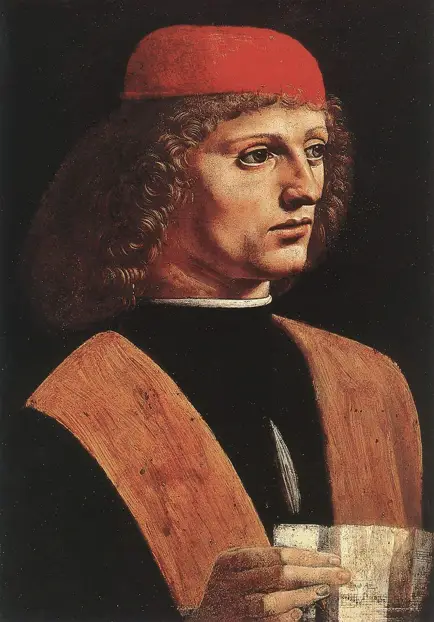
by Dukgyu | Jun 3, 2022 | Leonardo da Vinci Paintings
Leonardo da Vinci Portrait of a Musician
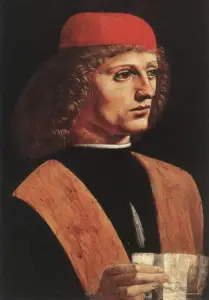
Potrait of a Musician (click for large image)
Title: Portrait of a Musician
Year: c. 1483-1487
Size: 44.7 x 32 cm
Medium: Oil on panel
Location: Pinacoteca Ambrosiana, Milan, Italy
The Portrait of a Musician depicts a young man with wavy shoulder-length hair, wearing a red cap, and concentrating intently on something outside. His look is heightened by clever lighting that draws emphasis to his face, particularly his huge glassy eyes. He’s dressed in a tight white undershirt. His black doublet is unfinished, and his brownish-orange stole is barely partially painted.
The colors have faded, most likely as a result of modest repainting and inadequate care. The doublet was most likely originally dark red, and the stole was bright yellow, according to a technical inspection of the piece.
The man’s mouth suggests a smile or that he is about to or has just finished singing, the impression of the light beyond the frame of his eyes is a distinguishing aspect of his face. The light dilates the pupils of both eyes, but the proper right pupil dilates significantly more than the left, which is not conceivable. Some claim that this is purely for dramatic effect so that the audience perceives movement from the musician’s left to right side of his face.
Leonardo da Vinci Portrait of a Musician was created in oils and perhaps tempera on a small walnut wood panel measuring 44.7 x 32 cm. It represents a young man in a three-quarter view with a bust-length right hand. The painting is mostly incomplete, except for the face and hair, but it’s in decent shape overall, with only the bottom right corner damaged. According to art historian Kenneth Clark, the Musician is arguably the best conserved of Leonardo’s extant paintings, despite color diminishing over time.
History of the Portrait of a Musician
The Portrait of a Musician is a painting from the same era as Lady with an Ermine. If Leonardo did paint it, Portrait of a Musician would be his only portrait of a man, according to some. There is no documentation for this painting, and there is no record of anyone ever commissioning it. Despite being widely regarded as his least important work, fate has decreed that it be the best preserved.
Unfortunately, the identity of the sitter is still unknown today. The sheet of paper was not visible prior to restoration in the early twentieth century, and it was supposed it was a portrait of Ludovico Sforza himself. Initially, the main candidate was Sforza’s court musician, Franchinus Gaffurius (1451 to 1522). Because both men worked at Duke’s court and thus knew one other, this became a very believable theory.
Many people feel that the subject’s face is strained because he is in the middle of a performance. The painting has also been seen as a reflection of Leonardo’s self-induced idea of painting’s superiority over other creative forms like poetry and music. Leonardo famously claimed at the start of his unfinished Libro de pittura
Original painting of the Portrait of a Musician
Although the attribution of Leonardo’s Portrait of a Musician painting to him was contentious in prior centuries, current art historians consider it to be one of his original works. For virtually as long as the painting has been known, there have been doubts about its attribution to Leonardo. It was identified by Leonardo in a 1672 catalog for the Pinacoteca Ambrosiana, while a 1686 inventory of the collection assigned it to Bernardino Luini. This was shortly removed and replaced with or rather by Leonardo.
When it comes down to it, all we can say for certain about Portrait Of A Musician is what we see in front of our eyes: how, well Leonardo obviously understood the bone structure under the flesh, how free the pose is, the exquisitely wavy hair and graceful fingers that are so common in Leonardo’s work.
Home
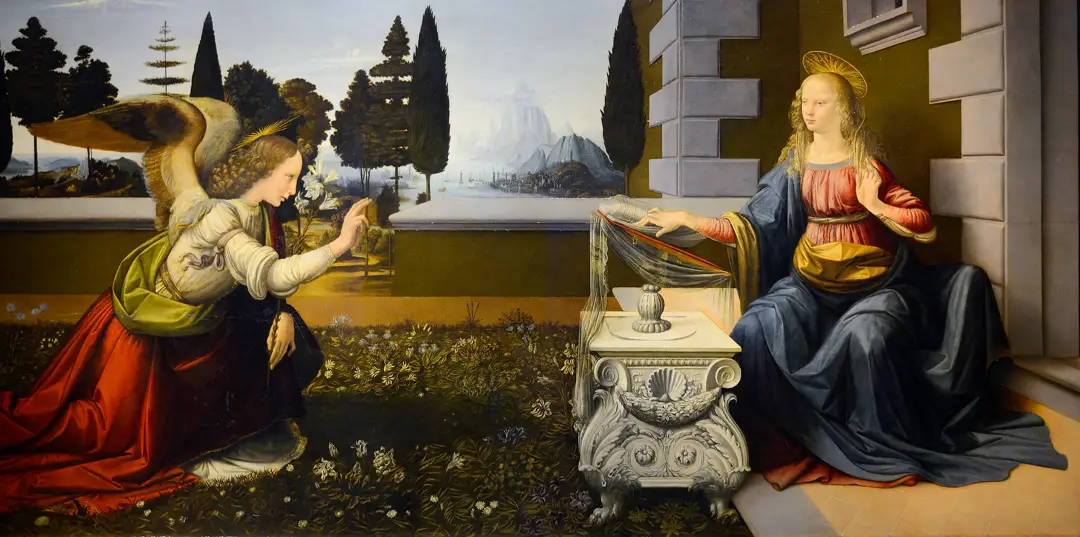
by Dukgyu | Jun 2, 2022 | Leonardo da Vinci Paintings
Leonardo da Vinci Annunciation
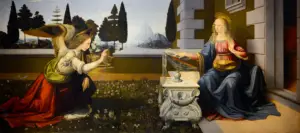
The Annunciation (click for large image)
Title: Annunciation
Year: c. 1472-1476
Size: 98 x 217 cm
Medium: Oil and tempera on panel
Location: Uffizi, Florence, Italy
Leonardo da Vinci The Annunciation is a masterpiece that has captivated art enthusiasts and historians alike. If you’re trying to understand its significance and beauty, exploring its elements and historical context can provide clarity and appreciation.
This painting, completed around 1472-1476, marks Leonardo’s earliest major work and showcases the influence of his master, Andrea del Verrocchio.
Set in a serene, natural landscape, the painting captures the biblical moment when the angel Gabriel announces to Mary that she will give birth to Jesus.
Leonardo’s use of oil and tempera on a poplar panel reflects his innovative spirit and technical prowess. The composition features the angel on the left, the Virgin on the right, and a lectern in between, creating a harmonious scene filled with symbolism and depth.
This early work of da Vinci can be found at the Uffizi Gallery in Florence, where it continues to draw visitors worldwide. The artwork highlights Leonardo’s emerging style and offers a glimpse into the rich artistic traditions of the Italian Renaissance.
By studying this piece, you can gain insight into the young da Vinci’s skill and the cultural heritage of 15th-century Florence.
Historical Context of ‘The Annunciation’
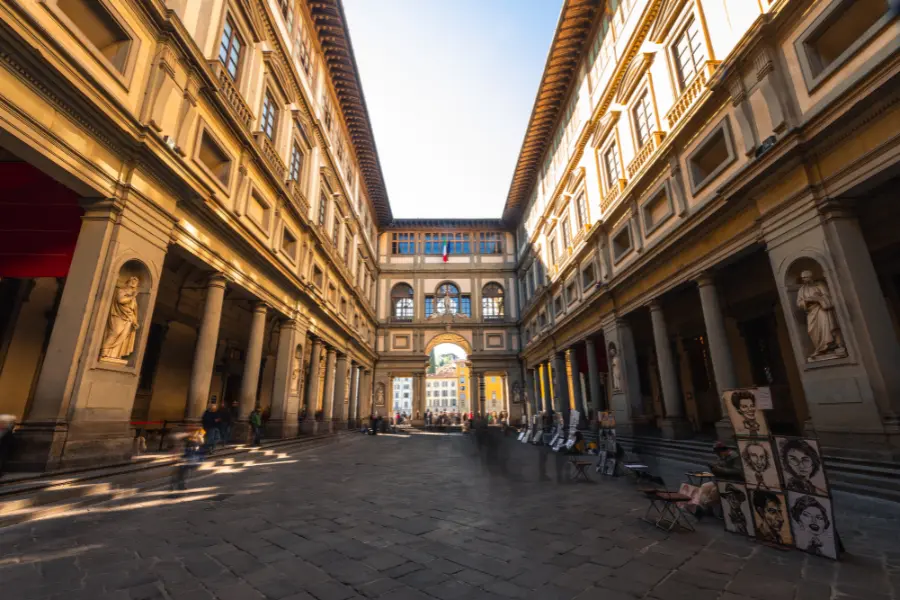
Uffizi Gallery in Florence, Italy
The Annunciation painting by Leonardo da Vinci holds great significance as it emerges from the rich cultural and artistic tradition of 15th-century Florence. During this time, Leonardo was still in the early stages of his career, developing distinct techniques that would later define his masterpieces.
Cultural and Artistic Climate of the 15th Century
Florence was a vibrant center of artistic innovation during the 15th century. Wealthy families commissioned works from the most talented artists, and the city saw a surge in patronage.
This period, known as the Renaissance, brought a renewed interest in classical art, science, and humanism. Artists began exploring realistic human forms, perspective, and dramatic lighting.
Leonardo da Vinci and contemporaries like Botticelli worked in an environment encouraging experimentation and creativity.
The Annunciation painting exemplifies this, showcasing Leonardo’s early exploration of perspective and human anatomy.
This painting, created using oil and tempera on a large poplar panel, demonstrates a skillful blend of innovation and traditional religious themes. It captures the moment the Angel Gabriel announces to Mary that she will give birth to Jesus.
Leonardo da Vinci’s Early Career
Leonardo began his career as an apprentice in the studio of Andrea del Verrocchio, a leading Florentine artist. This apprenticeship allowed Leonardo to learn various artistic techniques and skills.
The influence of Verrocchio’s workshop is evident in da Vinci’s early works, including The Annunciation.
At the time, Leonardo was tasked with experimenting and perfecting his craft. The Annunciation painting by Leonardo da Vinci marks his emergence as a talented artist, showcasing his ability to blend scientific observation with artistic expression.
His intricate detailing and innovative use of perspective reflect his potential, setting the stage for future masterpieces like the Mona Lisa and The Last Supper.
Analysis of the Painting
Leonardo da Vinci Annunciation showcases the artist’s early expertise in composition, color, and symbolic representation. This painting features complex spatial design, remarkable use of light and shadow, and layered iconography.
Composition and Use of Space
The painting, completed between 1472 and 1476, illustrates da Vinci’s proficiency in linear perspective. He uses a vanishing point to create a sense of depth.
The figures of the angel and Mary are placed in harmony, allowing for a balanced composition. Mary is positioned on the right, reading a book, while the angel Gabriel is on the left, kneeling.
The background showcases a garden and mountains, adding depth and drawing viewers into the scene. This careful arrangement demonstrates da Vinci’s early commitment to achieving naturalism in his work.
Color and Light Techniques
In The Annunciation, Leonardo da Vinci brilliantly employs a mix of oil and tempera on poplar wood, giving the painting a rich texture.
Natural light pouring over the scene highlights the delicate details on the clothing and faces of the figures. Soft shadows provide depth, creating a three-dimensional effect.
The varied hues establish a serene atmosphere, enhancing the spiritual nature of the event being depicted.
Symbolism and Iconography
The Annunciation painting da Vinci expertly incorporates symbols common to the narrative of the Annunciation.
Mary’s posture and the book suggest wisdom and devotion. The angel Gabriel holds a lily, a symbol of Mary’s purity. In the background, the garden refers to innocence and paradise.
These elements, combined with the artist’s focus on realistic human emotions and expressions, make this work significant in studying Renaissance art.
Technical Aspects and Conservation
Leonardo da Vinci’s The Annunciation showcases masterful use of perspective and materials typical of the Italian Renaissance. Its conservation has involved meticulous efforts to preserve the painting’s intricate details and vibrant colors over time.
Materials and Methods
Leonardo da Vinci created The Annunciation using oil and tempera on a large poplar panel. This choice of materials allowed him to produce fine details and subtle gradations in tone and color.
The painting features a well-established use of linear perspective, effectively creating depth by having parallel lines converge at a vanishing point.
The application of sfumato, a technique Leonardo was known for, can be seen in the soft transitions between light and shadow. This creates a lifelike and almost three-dimensional effect. Delicate brushwork brings out textures in the figures and the serene landscape.
History of Restoration
The Annunciation has undergone several restoration efforts to maintain its original brilliance.
Significant attention has been given to cleaning the surface and stabilizing the panel. Old varnishes were removed in past restorations to reveal Leonardo’s vibrant color palette.
X-ray imaging has played a crucial role in analyzing the painting’s layers, helping conservators understand the artist’s process and correct any alterations made in previous restorations.
These insights have been crucial for preserving delicate features like the angel Gabriel’s wings and the Virgin Mary’s expression.
Such careful restoration ensures that future generations can continue to enjoy The Annunciation painting as a masterpiece of Renaissance art.
Leonardo’s Influence and Legacy

The Annunciation by Leonardo da Vinci (left) and Botticelli (right)
Leonardo da Vinci’s works have deeply impacted both artistic and scientific fields. His painting, The Annunciation, exemplifies his legacy’s blend of creative talent and innovative thought.
Impact on Renaissance Art
Leonardo da Vinci was a driving force in advancing Renaissance art. His use of perspective and human anatomy in The Annunciation revolutionized artistic techniques.
The painting’s detailed portrayal of figures and architecture reflects a mastery of spatial awareness, inspiring artists like Michelangelo and Raphael.
His ability to convey emotion and movement differed from the rigid styles of earlier periods. The fluid grace of figures in The Annunciation influenced countless artists, establishing new standards in art while furthering the humanist movement that defined the Renaissance.
Modern Perceptions and Interpretations
Today, The Annunciation by Leonardo da Vinci continues to captivate audiences and art scholars. Its intricate details and pioneering use of light and shadow invite ongoing analysis and interpretation.
The painting is often celebrated for its artistic value and embodying the era’s intellectual curiosity.
Contemporary art historians often compare Leonardo’s work with his peers, recognizing the pantheon in which he stands among Renaissance greats.
In particular, comparisons with works like Botticelli’s Annunciation help highlight Leonrdo’s unique contributions.
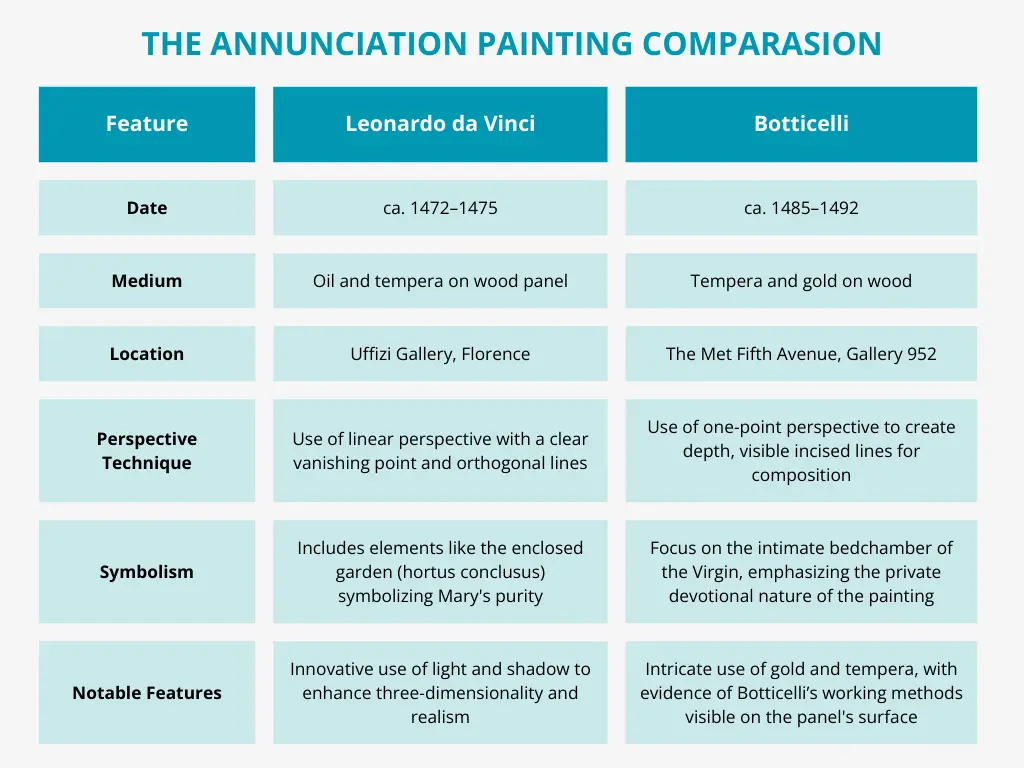
The enduring relevance of his techniques and vision is evident in modern discussions surrounding innovation and creativity in art.
His legacy persists through numerous famous paintings of the Annunciation, ensuring his status as a pivotal figure in art history.
Location and Public Display
The Annunciation by Leonardo da Vinci is housed in the Uffizi Gallery in Florence, a prominent location attracting global art enthusiasts. Visitors can explore the exhibition, which is accessible to the public, offering insights into this iconic Renaissance work.
The Uffizi Gallery
The Uffizi Gallery in Florence, Italy, is the home of The Annunciation by Leonardo da Vinci. This esteemed gallery is one of the most significant art museums in the world. It offers a chance to view masterpieces from the Renaissance period, including this renowned work.
Arriving at the gallery in 1867, the painting was transferred from the San Bartolomeo Monastery.
Situated in a spacious room dedicated to Leonardo, the gallery provides ample opportunities to appreciate the details of the artwork. The painting signifies da Vinci’s early work, highlighting his initial style influenced by Andrea del Verrocchio.
Exhibition and Accessibility
Visitors to the Uffizi Gallery can witness The Annunciation painting displayed in a well-organized botanical hall. The gallery’s layout enhances viewing by providing clear sightlines and adequate lighting.
The lighting allows viewers to see the subtleties of da Vinci’s technique.
The gallery’s key feature is accessibility. Guides and information in multiple languages, including brochures and audio tours, allow viewers to engage deeply with the art.
The gallery also ensures accommodations for individuals with mobility challenges, making it inclusive. Regular exhibitions and special events further encourage the public to learn about Leonardo da Vinci’s legendary works of art.
Final Thoughts
Leonardo da Vinci’s The Annunciation is a remarkable example of early Renaissance art. Painted between 1472 and 1476, it showcases Leonardo’s developing style and use of perspective.
The painting is a collaborative effort. While Leonardo completed the final touches, he might have worked alongside other artists. This gives the painting a unique blend of styles, with Leonardo’s touch evident in the intricate details.
Several elements in The Annunciation carry deep symbolic meanings. The angel Gabriel holds a lily, symbolizing purity, while Mary’s book represents divine wisdom.
Such symbols highlight themes of innocence and faith.
The painting also demonstrates Leonardo’s mastery of light and shadow. The gentle transition of shades creates depth, illustrating his grasp of three-dimensional effects. This technique contributes to the painting’s realistic quality.
Key Takeaways: Leonardo da Vinci The Annunciation blends artistic brilliance and symbolism. Its details and composition reveal the hallmarks of Leonardo’s genius during his formative years.
Understanding the context and craft of this artwork enhances appreciation for its enduring legacy.
Frequently Asked Questions
Leonardo da Vinci’s Annunciation is one of his early works, created as an apprentice. It showcases his budding painting skills and offers insight into his methods and inspirations.
Where is Leonardo da Vinci’s Annunciation?
Leonardo da Vinci’s “Annunciation” is housed at the Uffizi Gallery in Florence. It has been part of their collection for many years and remains a significant piece of Renaissance art.
What is the Annunciation technique of Leonardo da Vinci?
Leonardo used oil and tempera on a large poplar panel for this painting. This combination allowed him to achieve detailed textures and subtle transitions in light and shadow.
How old was Leonardo da Vinci when he painted the Annunciation?
Leonardo da Vinci painted the Annunciation in his early twenties, between 1472 and 1476, during his apprenticeship with Andrea del Verrocchio.
Why did Leonardo da Vinci paint the Annunciation?
Da Vinci painted the “Annunciation” as part of a popular religious theme in 15th-century art. It was a common subject that depicted the angel Gabriel announcing to Mary that she would bear the Son of God.
What is the story of the Annunciation?
The Annunciation is a biblical event where the angel Gabriel visited the Virgin Mary. Gabriel announced that Mary would conceive and become the mother of Jesus Christ, emphasizing her role in Christian theology.
Why did Da Vinci write backward?
Leonardo often wrote notes in reverse script, which some believe was to keep his ideas private or function as shorthand. This method also deterred others from quickly reading his work.
What are some facts about the Annunciation painting?
The painting includes intricate details, like the angel’s wings modeled after birds, and careful use of perspective to create depth. It is considered one of Leonardo’s earliest significant works.
Where is the lost Leonardo painting?
The lost Leonardo painting is often called the Battle of Anghiari. Many believe it is hidden beneath other artworks in Florence’s Palazzo Vecchio.
What is the famous painting of the Annunciation?
Leonardo’s Annunciation is one of the most well-known representations of the biblical scene. It is admired for its composition and Leonardo’s developing techniques.
Where is the Last Supper painting?
Leonardo da Vinci’s The Last Supper is in Milan, Italy, in the Convent of Santa Maria delle Grazie. It is one of his most renowned masterpieces. The painting is known for its composition and experimental use of medium.
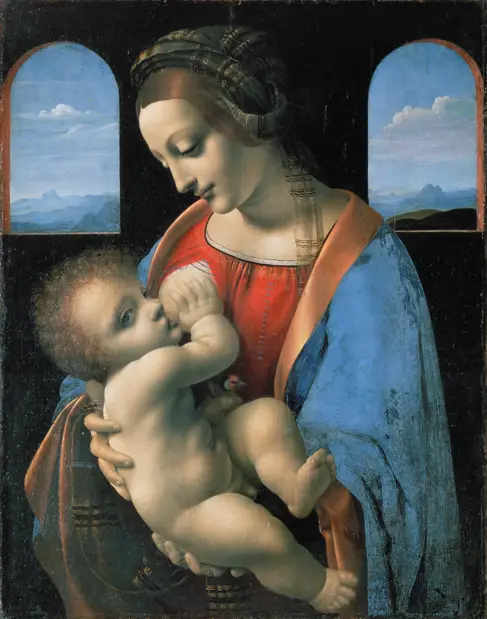
by Dukgyu | Jun 1, 2022 | Leonardo da Vinci Paintings
Leonardo da Vinci Madonna Litta
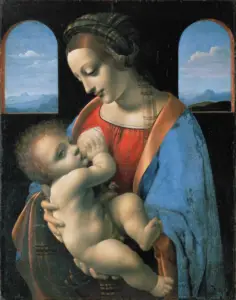
Madonna Litta (click for large image)
Title: Madonna Litta
Year: c. 1490
Size: 42 x 33 cm
Medium: Tempera on canvas
Location: Hermitage Museum, Saint Petersburg, Russia
The Madonna Litta by Leonardo da Vinci has its figures positioned in a dark room with two arched arches, similar to his earlier Madonna of the Carnation, and a mountainous scene in aerial view can be seen beyond. Christ holds a goldfinch in his left hand as a symbol of his impending Passion.
The Virgin Mary is breastfeeding Baby Jesus. While breastfeeding, Mary appears respectable. She is looking at Jesus with her eyelashes dropped. She is dressed in a brilliant red gown with an orange-copper border and a light blue mantle. She covers her head with a transparent veil, which extends under her robe to her right and left hands.
Baby Jesus has curly hair and appears to be a healthy, fat infant. He resembles, albeit slightly younger, Baby Jesus in Leonardo da Vinci’s Virgin of the Rocks in the National Gallery. Jesus enthusiastically takes his mother’s breast while glancing around to ensure he is not missing anything in his surroundings. He clutches Mary’s breast in his right hand and a goldfinch in his left.
Interestingly, Mary and Jesus do not have a halo around their heads, which is unusual for Leonardo but not uncommon in his work. In the background, two symmetrical arched windows show a mountain panorama and a blue sky with clouds.
History of the Madonna Litta
The Madonna Litta painting could be one of the Madonna and Child paintings recorded in Leonardo’s studio prior to or during his first Milanese period 1481 to 1483. Leonardo stated on a drawing in the Uffizi that he had begun “two Virgin Maries” in late 1478, and an inventory of his workshop written in 1482 (part of the Codex Atlanticus) cites two paintings of “Our Lady” once more.
According to several readings, the second of them is either “nearly finished, in profile” or “finished, almost in profile.” The Virgin’s head in the Madonna Litta might be described in either way, hence it has been suggested that the painting was started during Leonardo’s first Florentine era and then abandoned until it was completed by a pupil in Milan.
However, scientific investigation of the picture has revealed that it was created by only one person. Scholars disagree on the piece’s attribution, with some claiming it is the work of a Leonardo disciple such as Marco d’Oggiono or Giovanni Antonio Boltraffio; however, the Hermitage Museum believes it is an autograph work by Leonardo. The picture was named after the House of Litta, a Milanese noble family that owned it for much of the nineteenth century.
Madonna Litta meaning
The Virgin Mary breastfeeding Baby Jesus exemplifies motherhood and maternal love. Mary’s blue mantle represents the Church, while her scarlet garment represents Christ’s passion. The goldfinch represents Jesus’ future crucifixion. The mountain backdrop in the background shows God’s majesty in creating the world.
The plain countryside, Mary’s fairly boring attire, the shadows in this painting, and the absence of details in her face (compare this to Leonardo’s drawing in the Louvre above) are the primary reasons why people wonder if this painting is totally made by Leonardo. Some believe that these elements are not of the standard we’d expect from Leonardo.
Experts agree, however, that the design of the picture, particularly the difficult posture of Mary and Baby Jesus, could be by Leonardo. So it is not unlikely that Leonardo began this painting but that it was completed by an assistant, possibly Giovanni Antonio Boltraffio.
Home
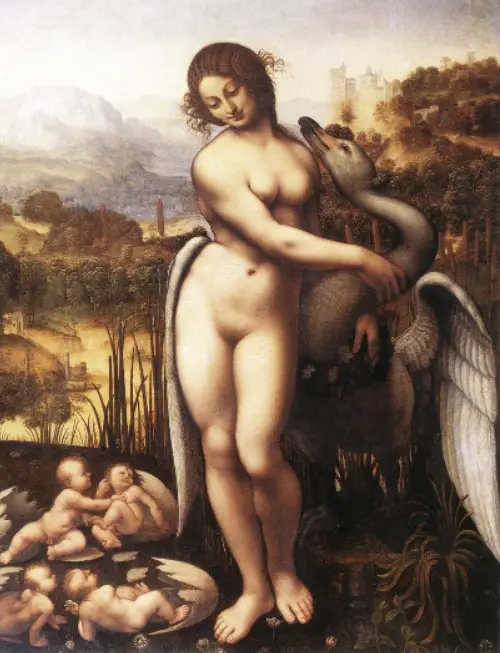
by Dukgyu | Jun 1, 2022 | Leonardo da Vinci Paintings
Leonardo da Vinci Leda and the Swan
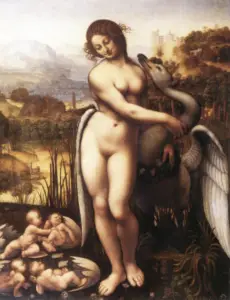
Leda and the Swan (click for large image)
Title: Leda and the Swan
Year: 1505-1510
Size: 69.5 x 73.7 cm
Medium: Oil on panel
Location: Wilton House, Salisbury, UK
In The Leda and the Swan painting, the naked woman who is Leda looks down compassionately on her babies, while the curves of her body contrast with the sinuous lines of the swan, its head resting on her shoulder. The artwork is also metaphorical; the branch of white blossom in Leda’s hand represents purity. Her slightly awkward attitude, with the infants on one side and the swan on the other, implies that she is torn between the human world and the magical event that has just occurred to her.
The setting is naturalistic, in contrast to the mythological quality of the plot. A granite block with carvings may be seen over Leda’s left shoulder. A little medieval village can be seen above her right shoulder. The sky above and the ground below are both realistic. This realism is explained by Leonardo’s evolution as an artist. Leonardo was preoccupied with the idea of Leda while working on the Mona Lisa, and while in Milan, he drew numerous sketches of the swans in the moat around the Castello. Cassiano del Pozzo described the painting in 1625; at the time, it was in the royal collection in Fontainebleau.
Leda and Zeus
The Leda with the Swan painting by Leonardo da Vinci depicts the Greek story of Leda, the daughter of King Aetolia. When Zeus, King of the Gods, saw Leda, he was so taken with her beauty that he transformed into a swan and married her. Leda gave birth to two eggs, each of which birthed twins.
It has been suggested that Leonardo’s Chatsworth drawing for Leda and the Swan was influenced by the Laocoön Group, an antique sculpture found in 1506: The subject’s body has a similar twist; the curve of the swan’s neck recalls the snake’s lithe form in Laocoön’s palm; Zeus’ rape recalls the serpents’ aggressive attack; and The infant next to Leda’s knee resembles Laocoön’s son on the right, who likewise has a sheer break at the wrist.
Leda and the Swan analysis
Many artists have attempted to depict Leda and the Swan throughout history. Artists such as Correggio, Michelangelo, and Paul Cezanne have created interpretations of the story.
Leonardo’s original painting has been lost; it was purportedly seen in Fontainebleau in 1625 and was described as being in horrible condition, having been done on three large panels that had split and fallen apart. Some academics question whether Leonardo actually finished the picture; we only know it from many replicas made by Leonardo’s pupils and from the master’s preliminary drawings.
Leda Greek Mythology
Since the classical period, this Greek myth has influenced artists. The connection between Leda and Zeus is depicted in a variety of ways, including violent and seductive. The majority of the artwork concentrates on the story’s enticing component.
The majority of the artworks depict specific themes that depict various aspects of the myth of Leda and the Swan. The setting of the story, the facial emotions of persons depicted in the painting, and the clothing objects depicted in the painting, as well as their color.
Many painters throughout history have explored the subject of Leda and the Swan. Among the painters who have created interpretations of the story are Correggio, Michelangelo, and Paul Cezanne.
Home
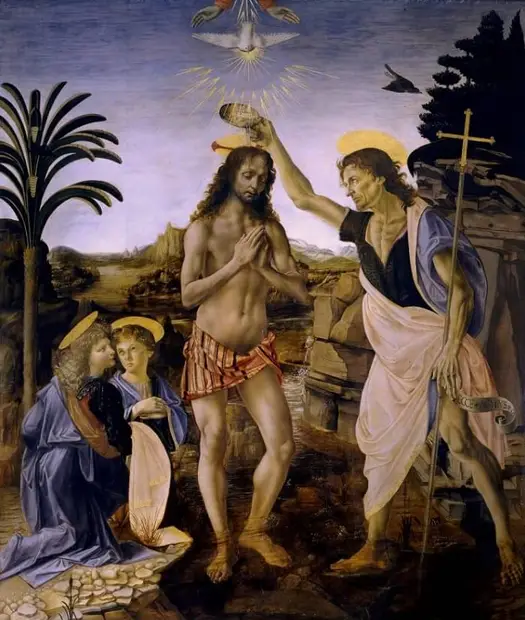
by Dukgyu | Jun 1, 2022 | Leonardo da Vinci Paintings
Leonardo da Vinci Baptism of Christ
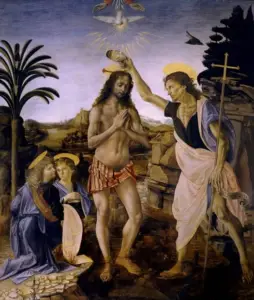
The Baptism of Christ
Title: The Baptism of Christ
Year: 1472-1475
Size: 177 x 151 cm
Medium: Oil on wood
Location: Uffizi, Florence, Italy
Leonardo da Vinci Baptism of Christ is a captivating masterpiece that beautifully illustrates the artistic collaboration between Leonardo and his master, Andrea del Verrocchio.
This artwork is notable for John the Baptist’s graceful depiction of the Baptism of Jesus, which highlights Leonardo’s early contributions.
Verrocchio and Leonardo’s combined effort resulted in a fascinating blending of styles, particularly evident in the meticulously painted angels.
This painting is a crucial reference point for those interested in Leonardo da Vinci‘s career progression.
At just 18 years old, Leonardo demonstrated remarkable talent, contributing to the detailed parts of the piece, especially one of the angels.
The painting is housed in the Uffizi Gallery, making it accessible to art enthusiasts who want to witness this historic work firsthand.
Art historians find “Baptism of Christ” particularly intriguing as it showcases the transition from traditional techniques to innovative approaches that Leonardo would later master.
The panel’s use of oil and tempera reflects the period’s experimentation, setting the stage for future developments in Renaissance art.
This work exemplifies how youthful creativity and experienced guidance can produce an enduring legacy.
Historical Context of the Painting
The Baptism of Christ painting, a collaboration primarily between Leonardo da Vinci and Andrea del Verrocchio, reflects significant influences from the Early Renaissance. This artwork showcases the blend of individual innovation and traditional techniques prevalent at the time.
Early Renaissance Influence
During the Early Renaissance, artists focused on bringing realism into their works through perspective and human anatomy. The Baptism of Christ painting is an excellent example of this transition.
This period was marked by advancements in understanding light, shadow, and three-dimensionality. Artists strived to depict religious themes with more naturalism.
Leonardo’s work on the Baptism of Jesus painting demonstrates these developments.
His understanding of human emotions and anatomy is evident in the angel figures he contributed to.
The softness in facial features and detailed depiction of drapery showcase techniques ahead of his time. This reflects the Renaissance’s move towards scientific inquiry and thorough observation.
Collaboration with Verrocchio
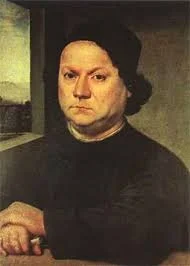
Andrea del Verrocchio (1435-1488)
The collaboration between Verrocchio and Leonardo on the Baptism of Christ marks a pivotal moment in art history. Verrocchio, a master in Florence, often worked with talented apprentices in his studio.
Leonardo’s role was significant; he painted some figures, especially the angel on the left. His use of light and texture indicated his emerging style.
Verrocchio’s mentorship allowed da Vinci to explore his talents while conforming to the studio’s established techniques.
This partnership produced a unique synthesis of styles. Leonardo’s soft, expressive profiles complement Verrocchio’s strong outlines and careful compositions.
This partnership highlights how mentorship and collaboration were crucial in the art community of the Renaissance era.
The Baptism of Christ Leonardo da Vinci’s work remains invaluable for understanding these early collaborative efforts between a master and a protégé.
Artistic Analysis of ‘Baptism of Christ’
Leonardo da Vinci‘s involvement in the Baptism of Christ painting, alongside Andrea del Verrocchio, exemplifies his early mastery of composition and symbolic depth. The piece beautifully combines technical skill with thematic richness.
Composition and Technique
The Baptism of Christ demonstrates remarkable composition and technique attributed to Verrocchio and Leonardo da Vinci.
The painting depicts Jesus being baptized by John the Baptist, one of the pivotal moments in religious art.
Da Vinci’s role was primarily to paint parts of the composition, including the detailed angel on the left, showcasing his advanced grasp of human anatomy and emotion.
Leonardo’s use of light and shadow adds depth, and his technique, chiaroscuro, gives the figures a lifelike quality.
The composition is balanced. The central figures of Jesus and John draw the viewer’s eye, while the angels add a heavenly touch.
These elements underscore the collaborative dynamic between master and apprentice present in the studio.
Symbolism and Themes
The Baptism of Christ painting is rich with symbolism, conveying spiritual renewal and divine purity themes.
The central act of baptism symbolizes cleansing, and the serene expressions on the figures suggest inner peace and acceptance.
The significant figures of water and the dove in the background represent the Holy Spirit, adding layers of symbolic meaning.
Leonardo’s subtle touches, such as the angel’s facial expression, reflect his intuitive understanding of emotional depth.
His and Verrocchio’s work imbues the painting with a sense of divine intervention, highlighting the transformative power of Christ’s baptism.
The meticulous attention to theme and detail marks it as a significant work from the Renaissance period.
Leonardo da Vinci’s Contribution
Leonardo da Vinci played a significant role in the collaborative creation of The Baptism of Christ. His innovations added depth and vitality to the work, showcasing his emerging talent during his formative years as an artist. The painting is a fusion of expertise, blending Verrocchio’s mastery with Leonardo’s unique touch.
Innovative Use of Light
Da Vinci mastered using light and shadow to enhance the realism of The Baptism of Christ.
His technique, known as chiaroscuro, brought figures to life, making them appear three-dimensional against the background.
This groundbreaking approach demonstrated his deep interest in how light interacts with surfaces.
Leonardo’s expertise in this area was revolutionary at the time.
By observing the play of light, he added depth that differed from the flatter depictions common in earlier paintings.
This skillful treatment of light was an early indicator of his genius and would continue to influence his later works.
Figures Painted by da Vinci
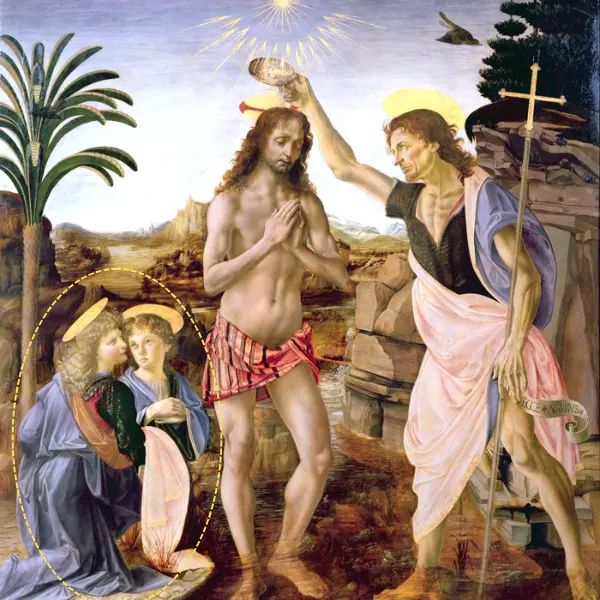
Leonardo da Vinci painted angels (yellow circle on the left) for the Baptism of Christ
Leonardo da Vinci contributed significantly to the painting of Baptism of Christ by focusing on particular figures within the composition.
Notably, he painted an angel, infusing it with delicacy and grace.
This painting section displayed his ability to render detailed anatomical features precisely.
His portrayal of the angel stood out for its refined elegance, distinct from other figures in the piece.
This distinction highlights Leonardo’s emerging individual style, which differed from other workshop artists.
His skillful depiction of the human form would become a hallmark of his later masterpieces.
Restoration and Preservation Efforts
The “Baptism of Christ” painting by Leonardo da Vinci and Andrea del Verrocchio has undergone various restoration and preservation efforts. These efforts aim to maintain the artwork’s integrity and ensure its survival for future generations.
Conservation History
Leonardo da Vinci Baptism of Christ faced challenges common to many Renaissance paintings.
Initially housed in Florentine churches, it was subject to environmental damage like humidity and dust.
Restoration efforts began early in the 19th century, focusing on cleaning and stabilizing the artwork.
In the 20th century, restorers employed techniques to remove varnish, address color degradation, and repair physical damage.
Documentation from the Uffizi Galleries highlights these interventions.
Conservators examined the paint layers and composition, revealing not just Leonardo’s hand but contributions from other artists in Verrocchio’s workshop.
These detailed analyses ensured authenticity and fidelity to the original work.
Modern Restoration Techniques
Today, advanced technology plays a crucial role in preserving Leonardo da Vinci’s painting of the Baptism of Christ.
Infrared reflectography and X-ray fluorescence are commonly used to study the underdrawings and materials.
These techniques help identify pigments and map the artist’s changes during painting.
Recently, efforts have focused on controlling the painting’s environment.
Humidity control and minimal light exposure in display areas are vital to prevent further deterioration.
Innovations in restorative materials also aid in filling cracks and stabilizing faded sections without altering the original texture.
The Wikipedia entry on the Baptism of Christ notes these advancements have significantly improved the painting’s condition, ensuring that this masterpiece by da Vinci and Verrocchio remains vibrant and well-preserved.
Impact and Legacy
Leonardo da Vinci’s collaboration on the Baptism of Christ showcases his early artistic skills and sets a precedent for the transformative techniques he would become famous for. This painting, completed around 1475, is significant in the art world and da Vinci’s career development.
Influence on Later Artists
The Baptism of Christ contributed significantly to Renaissance art.
Leonardo was responsible for painting the angel on the left side, introducing innovative techniques like sfumato and fine details that captured emotion and anatomy with unprecedented precision.
Other painters took notice of this blend of realism and detail.
Leonardo’s methods later influenced masters such as Michelangelo and Raphael, who incorporated aspects of his approach into their artworks.
This painting is a foundational example of Leonardo’s artistry, showing traits that would define his later pieces, like The Last Supper and Mona Lisa.
Place in da Vinci’s Oeuvre
The Baptism of Christ is one of Leonardo da Vinci’s earliest works.
Though primarily attributed to Andrea del Verrocchio, this project marked Leonardo’s first major contribution.
It was a collaborative effort in Verrocchio’s workshop, where Leonardo learned and refined his skills.
The angel’s expressive features and soft form show his burgeoning talent for conveying human emotion and anatomical accuracy.
This early involvement in the Baptism of Christ painting shaped his future style, which is why this work is often highlighted when discussing Leonardo’s artistic development.
Final Thoughts
Leonardo da Vinci Baptism of Christ is a significant example of Renaissance art. The painting displays a remarkable blend of artistic skill and innovative techniques.
Leonardo’s contribution to the work, especially the rendering of human anatomy and emotion, showcases his deep understanding of art and science.
Key Takeaways: Leonardo da Vinci’s work on Baptism of Christ reflects his unique artistic perspective and collaborative spirit. The harmonious combination of intricate details and expressive figures highlights his role in advancing Renaissance art.
Frequently Asked Questions
Leonardo da Vinci significantly created The Baptism of Christ alongside Andrea del Verrocchio. This piece exemplifies his contributions to art and the religious context of the time.
Was Leonardo da Vinci baptized?
There are no specific records about Leonardo da Vinci’s baptism, but given his Catholic upbringing, it is highly likely he was baptized as an infant in the Catholic Church.
Which angel did Da Vinci paint in The Baptism of Christ?
Leonardo da Vinci is believed to have painted the angel on the left side of The Baptism of Christ, showcasing his emerging style and attention to detail.
Where is the Baptism of Christ painting located?
The painting The Baptism of Christ is in the Uffizi Gallery in Florence, Italy, where it has been preserved and displayed for public viewing.
How many years were there between Jesus and Leonardo da Vinci?
Jesus was born around 4-6 BC and lived until approximately 30-33 AD. Leonardo da Vinci was born in 1452 AD, approximately 1,450 years after Jesus.
Did Leonardo da Vinci believe in Jesus?
Leonardo da Vinci lived in a predominantly Christian society and often explored religious themes in his work, though his personal beliefs about Jesus are not well-documented.
What were Leonardo da Vinci’s last words?
Leonardo da Vinci’s supposed last words expressed regret about not having accomplished more in his lifetime, highlighting his relentless pursuit of knowledge and perfection.
What did Leonardo da Vinci do for the church?
Leonardo da Vinci contributed to religious art through works like The Last Supper and The Baptism of Christ, creating influential pieces that depicted key Christian narratives.
Why did Leonardo da Vinci paint The Last Supper?
Ludovico Sforza commissioned The Last Supper in Milan for the Convent of Santa Maria delle Grazie. Leonardo focused on capturing the apostles’ emotions and expressions during the pivotal moment of Jesus’s last meal.
When did Leonardo da Vinci paint St John the Baptist?
Leonardo completed the painting St. John the Baptist between 1513 and 1516 while in France, marking one of his final pieces.
What is the most reproduced religious painting of Leonardo da Vinci?
Leonardo’s The Last Supper is one of the most reproduced religious paintings. It is celebrated for its composition and profound depiction of a significant biblical event.
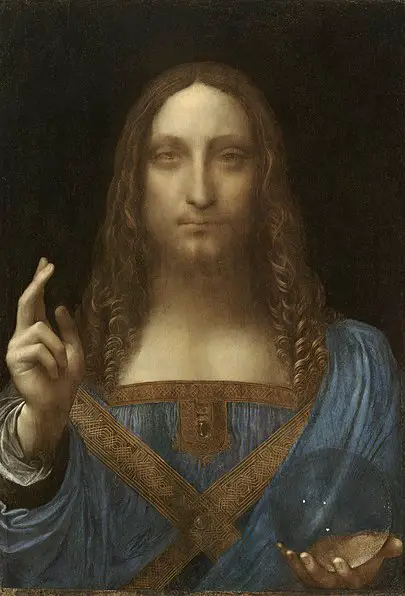
by Dukgyu | May 31, 2022 | Leonardo da Vinci Paintings
Leonardo da vinci Salvator Mundi
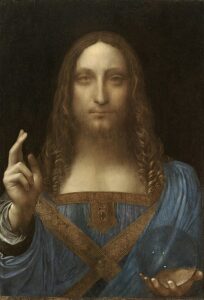
Salvator Mundi (click for large image)
Title: Salvator Mundi
Year: c. 1499-1510
Size: 45.4 x 65.6 cm
Medium: Oil on walnut panel
Location: Mohammed bin Salman (owner), Saudi Arabia
Salvator Mundi is a masterpiece that has fascinated and puzzled art enthusiasts worldwide. This painting, attributed to Leonardo da Vinci, portrays Christ with his right hand raised in blessing and a crystal orb in his left hand.
Salvator Mundi’s iconic status skyrocketed when it was sold for $450.3 million at Christie’s auction in 2017, becoming the most expensive painting ever sold.
For those questioning the painting’s sky-high price and authenticity, this article will unravel the mystery behind its attribution and restoration process. Salvator Mundi’s journey includes its rediscovery, extensive restoration, and controversial sale, contributing to its title as the world’s most controversial painting. You will gain insight into the controversies and history surrounding this enigmatic artwork.
Art historians and enthusiasts alike ponder the symbolism captured in Salvator Mundi. The painting’s eschatological themes and religious iconography provoke discussion on its deeper meanings.
Exploring the historical context and its secrets reveals why Salvator Mundi remains a captivating subject for debate and admiration today.
Historical Overview
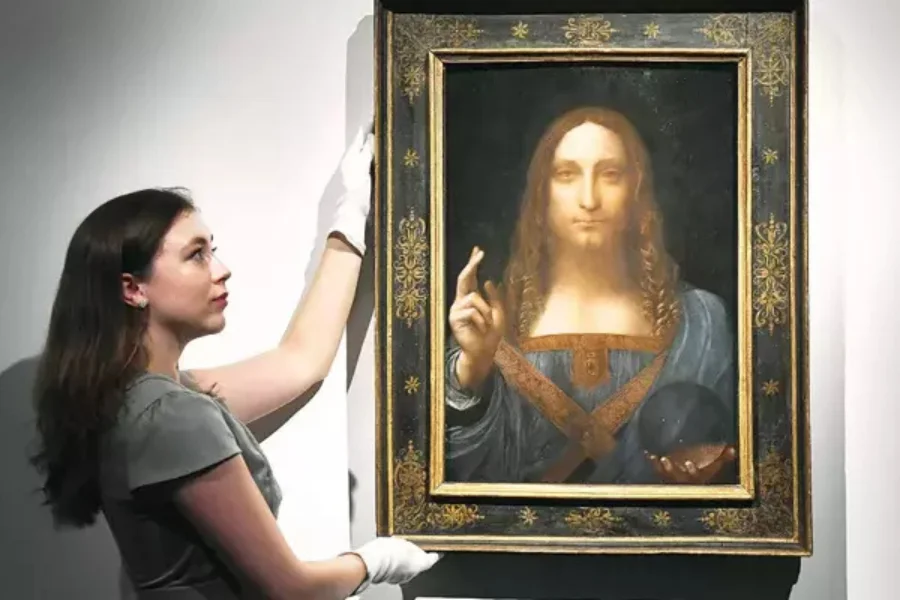
Leonardo da Vinci’s Salvator Mundi painting
Leonardo da Vinci’s “Salvator Mundi” is a painting with a rich and complex history. Its journey and the mysteries surrounding its creation and ownership have intrigued historians and art lovers.
Creation and Artist
“Salvator Mundi,” which means “Savior of the World,” is attributed to the legendary artist Leonardo da Vinci.
The painting, created around 1500, depicts Jesus holding a crystal orb, symbolizing his role as a savior. Leonardo’s signature style shines through the detailed rendering of textures and Jesus’s serene expression.
Though Leonardian, debates continue about whether the master himself painted it entirely or if it involved contributions from his workshop, a common practice during the Renaissance.
This painting exemplifies the artist’s talent in capturing divine serenity and depth, making it one of the most debated artworks globally. It has been a subject of extensive analysis and study, highlighting its importance in art history.
Provenance and Ownership
The painting has had a turbulent ownership history, adding to its allure and controversy.
Rediscovered in 2005, “Salvator Mundi” was initially bought at a small auction in New Orleans despite being heavily overpainted and in poor condition.
Art collectors and experts debated its authenticity until it was restored and authenticated as a da Vinci work, significantly increasing its value. In 2017, it made headlines when it sold at auction for a record Salvator Mundi price of $450.3 million, making it the most expensive painting ever sold.
The current owner is believed to be Mohammed bin Salman, the Crown Prince of Saudi Arabia, though its exact location remains uncertain. This ownership history reflects the painting’s complex journey through time and the intrigue surrounding it.
Artistic Significance
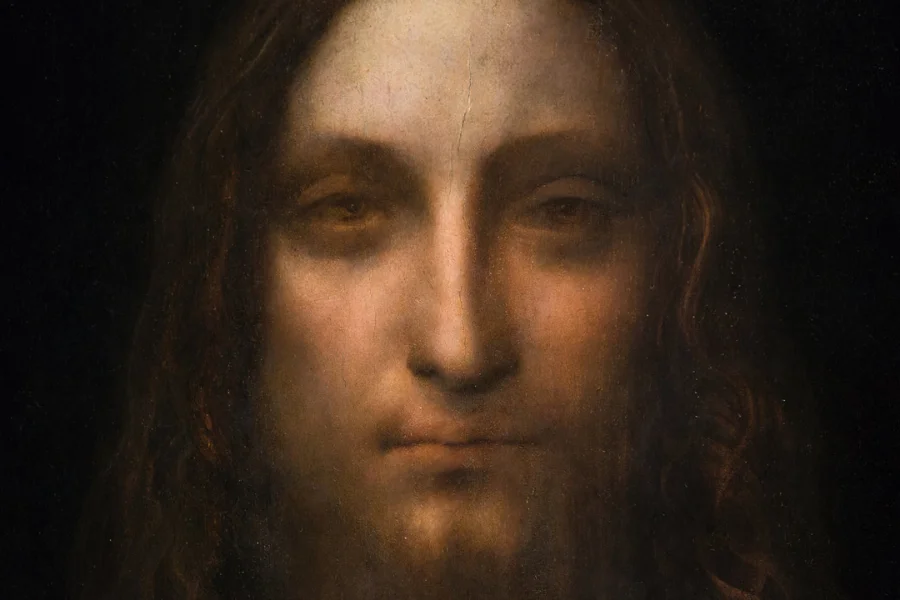
Detailed face and soft edges highlight the Salvator Mundi’s artistic significance
The Salvator Mundi painting, attributed to Leonardo da Vinci, holds a unique place in art history for its intricate composition and masterful techniques. Its symbolism and style offer deep insights into the artistic vision and the period during which it was created.
Composition and Subject
The composition of the Salvator Mundi centers on a serene figure of Christ, depicted as the Savior of the World, which is what “Salvator Mundi” translates to.
Christ’s right hand is raised in blessing, while his left holds a transparent orb, possibly symbolizing the cosmos. The figure’s calm expression and divine gesture are typical of Leonardo da Vinci’s mastery of portraying subtle human emotions.
Da Vinci’s attention to detail is evident in the intricate curls of Christ’s hair and the delicate rendering of his robes. The painting’s symmetrical balance and light guide the viewer’s eyes toward the focal point, his face and hands.
This compositional structure enhances the viewer’s engagement and reflects the spiritual significance inherent in the subject matter.
Style and Techniques
Leonardo da Vinci’s Salvator Mundi showcases his unparalleled techniques, such as sfumato, which softens the transitions between colors, creating a lifelike quality. The muted color palette aligns with the Renaissance ideals of harmony and balance, emphasizing the spiritual over the earthly.
The translucent quality of Christ’s orb is achieved through layers of thin glazes, a hallmark of da Vinci’s style. This technique adds depth and realism, underscoring his innovative approach to painting.
The contrast between the detailed rendering of Christ’s face and the softer edges of the surrounding elements enhances the portrait’s focal impact. This combination of style and technique highlights why the painting is considered a significant work of art today.
Controversies
The Salvator Mundi painting has sparked significant debates over its authenticity and the perplexing details surrounding its sales and auctions. These controversies have captivated the art world and the general public alike.
Authenticity Debates
The main contention is whether Leonardo da Vinci truly crafted the Salvator Mundi. Some experts assert it is a genuine work by Leonardo, while others argue it could be a product of his workshop or a skilled later artist.
This disagreement arises partly because the painting’s restoration efforts have been significantly retouched. The actual authorship is critical because it impacts the painting’s monetary and historical value.
Many analysts scrutinize the techniques used in the painting, comparing them with known Leonardo works to ascertain its legitimacy. This continual debate underscores the complexity and intrigue surrounding Leonardo da Vinci’s Salvator Mundi.
Sale and Auction History
The Salvator Mundi has a contentious sale history, further fueling its notoriety. Initially bought for under $10,000 in 2005, it was sold at auction in 2017 for a staggering $450 million, cementing its place as the most expensive painting ever sold.
This dramatic increase has raised eyebrows regarding the dynamics of the art market and the motivations behind its purchase. The painting’s provenance has been questioned, with disputes surrounding its ownership and legal proceedings involving prominent personalities like Russian billionaire Dmitry Rybolovlev.
Speculation about its buyer, Saudi Arabia’s Mohammed bin Salman, added another layer of mystery and intrigue to its already complex tale.
Conservation and Restoration
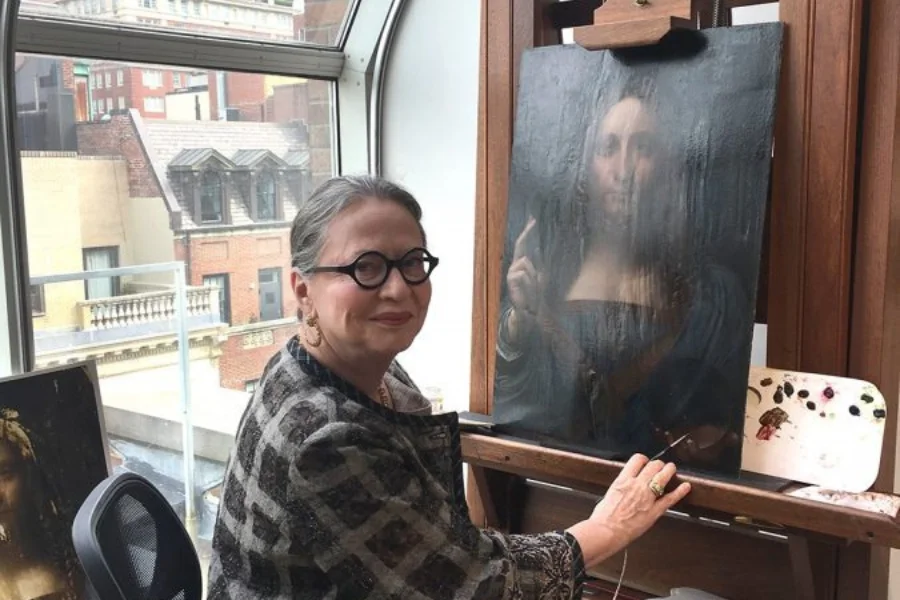
Dianne Modestini, an art conservator, restored Leonardo da Vinci’s ‘Salvator Mundi
Leonardo da Vinci’s masterpiece Salvator Mundi has undergone significant conservation and restoration efforts to preserve its historical and artistic value. Detailed condition reports, and thoughtful restoration efforts have been crucial in maintaining the integrity of this iconic artwork.
Condition Reports
Over the years, experts have meticulously documented the condition of the Salvator Mundi painting. Condition reports provide a comprehensive understanding of the artwork’s state, detailing areas of damage and previous restoration attempts.
These reports typically highlight issues such as paint loss, surface scratches, and areas where the original layers have deteriorated.
Maintaining an up-to-date record is crucial for a painting as significant as this. The reports help us understand the current state and guide future conservation efforts.
Leonardo da Vinci’s Salvator Mundi requires careful monitoring to preserve its historical and aesthetic qualities for future generations.
Restoration Efforts
The restoration of Leonardo da Vinci’s Salvator Mundi has involved many complex processes to address areas of damage and wear. Skilled conservators like Dianne Modestini have played key roles in these efforts.
Modestini worked intensively to clean and restore the painting, which had been overpainted and was in poor condition. Restorers carefully removed varnish and non-original paint layers to reveal Leonardo da Vinci’s underlying artistry.
Challenges included matching the original pigments and ensuring that any added elements did not alter the original composition. The successful restoration of the Salvator Mundi painting has secured its structural integrity and enhanced its appreciation, influencing factors like its historical significance and awe-inspiring price.
Cultural Impact

Salvator Mundi was sold at a Christie’s auction for $450.3 million in 2017
The Salvator Mundi by Leonardo da Vinci has left a profound mark on literature, media, and public exhibitions. Its mysterious history and astonishing auction price have sparked significant global interest.
In Literature and Media
Numerous books and documentaries have explored the Salvator Mundi painting. Authors often explore its mysterious provenance and the debate surrounding its attribution to Leonardo da Vinci.
This intrigue is fueled by the painting’s record-breaking sale at Christie’s auction house in 2017 for a staggering $450.3 million, which made headlines worldwide.
Documentaries delve into the complexities of the painting’s history and authenticity, raising questions about Salvator Mundi’s true origins and meaning. The painting’s elusive history and the controversy over its authenticity captivate audiences, making it a frequent topic in both scholarly and popular media.
Public Exhibitions and Displays
Due to its private ownership, public exhibitions of the Salvator Mundi are rare. The painting’s limited public display adds to its allure, as enthusiasts worldwide are eager for opportunities to see it. When it is like during the previews before the auction, the events attract significant attention.
Speculation about its future public appearances continues, especially given its acquisition by the Saudi Crown Prince Mohammed bin Salman.
The painting’s significance as a portrayal of Jesus resonates deeply, drawing religious and art scholars alike. Although the Salvator Mundi is more often out of view, its mystique ensures it remains a central figure in art discussions globally.
Final Thoughts
Salvator Mundi holds a unique position in art history. It merges spiritual depth with artistic mastery.
The work reflects Gian Lorenzo Bernini‘s focus on salvation, with Christ depicted raising his hand in blessing. This sculpture can be seen at Rome’s Leonardo Da Vinci-Fiumicino Airport, emphasizing its significance even in contemporary settings.
Bernini’s version, distinct from the famous painting attributed to Leonardo da Vinci, showcases the diversity in artistic interpretation. The da Vinci painting sold for a record $450 million, adding to its allure by sparking debate and appreciation in art.
Key Takeaways:
Salvator Mundi exemplifies profound religious and artistic themes. Understanding its history enriches one’s appreciation of these masterpieces. Visiting exhibitions and online resources can provide valuable insights for those interested in exploring Bernini and da Vinci more.
Frequently Asked Questions
Leonardo da Vinci’s “Salvator Mundi” is a painting renowned for its historical significance and intricate artistry. It remains a focus of interest due to ongoing debates about its provenance, current ownership, and market value.
What is so special about Salvator Mundi?
“Salvator Mundi” is a famous painting attributed to Leonardo da Vinci, one of the most influential artists of the Renaissance. It depicts Christ holding a crystal orb, symbolizing the cosmos, and captivates viewers.
Who bought Salvator Mundi for $450 million?
The identity of the buyer who purchased “Salvator Mundi” for $450 million at a Christie’s auction in 2017 remains uncertain. Many believe Saudi Arabia’s Crown Prince Mohammed bin Salman bought the painting through a proxy.
What is controversial about Salvator Mundi?
The primary controversy surrounding “Salvator Mundi” stems from doubts about its attribution and authenticity. Some experts argue that Leonardo may have partially painted it or that his studio had completed it.
Where is Salvator Mundi right now?
The location of Salvator Mundi is not publicly confirmed. It was supposed to be displayed in a museum or exhibit, but its absence has led to speculation about its whereabouts.
What is the mystery behind the Salvator Mundi?
The mystery of “Salvator Mundi” includes its past ownership records and the extent to which Leonardo himself painted it. These uncertainties fuel ongoing intrigue and discussion in the art world.
How much is Salvator Mundi worth today?
While “Salvator Mundi” was sold for $450 million in 2017, its current value could fluctuate based on market conditions and ongoing debates regarding its authenticity.
How was Salvator Mundi destroyed?
There is no evidence that Salvator Mundi has been destroyed. Given its importance and value, any reports suggesting damage would be significant news.
Is Mona Lisa worth more than Salvator Mundi?
The “Mona Lisa” is considered priceless and is rarely discussed in monetary terms. Though “Salvator Mundi” holds the record for the highest price paid at auction, the “Mona Lisa” is housed in the Louvre and is not for sale.
Who is the face of Salvator Mundi?
The face depicted in “Salvator Mundi” is that of Jesus Christ. This portrayal, featuring intricate detail and symbolism, is a testament to Leonardo da Vinci’s skill in capturing human expression.
Who owns the Mona Lisa?
The “Mona Lisa,” owned by the French government, has been permanently displayed at the Louvre Museum in Paris since the French Revolution.





















 Leonardo Bianchi,
the creator of Leonardo da Vinci's Inventions.
Thank you for visiting
Leonardo Bianchi,
the creator of Leonardo da Vinci's Inventions.
Thank you for visiting